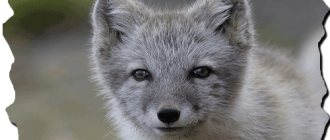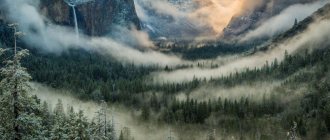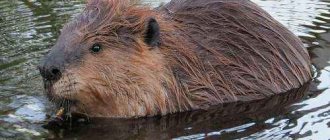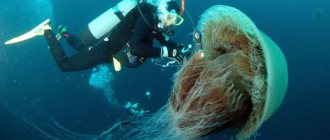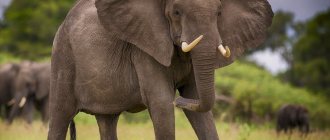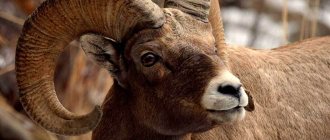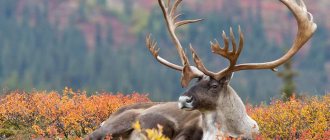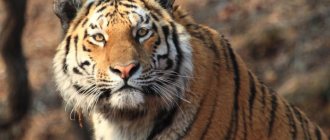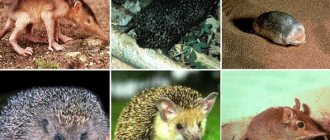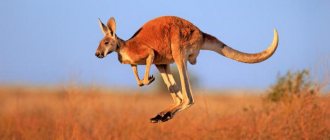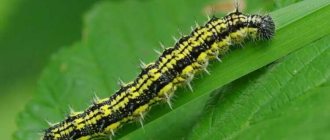A steppe is a flat area covered with grasses and shrubs. There are hot summers and cold winters; the climate of the steppes is characterized by irregular and scanty precipitation. The vegetation is represented by cereals, which tolerate drought and high temperatures well.
Thanks to its natural conditions, the steppes are home to unique representatives of the animal world. Many species are found nowhere else on the planet. Poaching has taken a heavy toll on the fauna of the steppes, but the populations of two iconic species - the saiga and Przewalski's horse - appear to be recovering.
Unfortunately, this unique biome has practically disappeared from the face of the Earth due to human activity. Much of the territory was used for agriculture and mining. Pristine areas of the steppe can only be found in nature reserves and national parks. Hundreds of plant species have been lost forever. Due to food shortages, human intervention and poaching, steppe animals have been pushed to the brink of extinction or migrated to other ecoregions.
Most fauna living in the steppe are grazing animals such as rabbits and horses. However, this natural area also has many unique species, such as the corsac fox, the clawed gerbil, the saiga antelope, the common lynx, the steppe kestrel, and the Bactrian camel. Most animals are herbivores, since the steppe has an abundance of grasses. However, there are exceptions such as the corsac and the lynx, which are carnivores.
Below are examples of some steppe animals with a brief description and photo:
Saiga antelope
The representative of the bovid family is currently classified as an endangered species. The body length of an adult is about 100-140 cm, weight - 20-40 kg, some animals reach a weight of more than 60 kg. A distinctive feature of the saiga is its nose, which resembles a short proboscis. The coat color changes depending on the season; winter fur is lighter and thicker than summer fur. Animals have learned to adapt to weather conditions. They prefer to live in large herds. In summer, saigas feed on grass shoots, and in winter they migrate to warmer regions to find food. The natural enemy is the steppe wolf.
Characteristics of the forest-steppe - where it is located, types, climate, soil, features
Forest-steppe is a natural area located in the Northern Hemisphere. Its characteristic feature is the simultaneous combination of features of steppes and forests in one territory. The further south you go, the fewer trees remain in this zone, the climate becomes hotter - the steppes begin. In the northern direction the situation is the opposite: the climate is cooler, there are more trees - the forest zone begins there. Flora and fauna are also mixed.
Typical forest-steppe landscape
Climate and soil
The forest-steppe is located in a temperate climate zone with characteristic weather conditions. About 600 mm of precipitation falls annually. Summers are usually hot and dry, and winters are mild. But most of all, the forest-steppe is characterized by changeable weather conditions. Therefore, there may be abnormal heat and severe frosts.
The most common types of soil are chernozems, brown soils, gray forest soils, chestnut soils, and gray soils. If in summer the climate throughout the entire forest-steppe zone is almost the same, then in winter there are significant differences between the eastern and western parts. They affect the plant composition.
prairie dog
Prairie dogs belong to the order of rodents. They got their name from the sound they make, which is reminiscent of a dog barking. On average, the body length is 30-40 cm, weight - 0.5-1.5 kg. The fur is brown, the back is painted a darker color. Prairie dogs live in colonies in underground burrows. The basis of their diet consists of shoots, seeds, buds, leaves and flowers of plants. In case of danger, animals begin to scream, giving signals to other relatives. Prairie dogs are hunted by birds of prey and foxes.
Red Book
The Russian steppe is rich in rare specimens of birds and animals, which are under state protection and listed in the Red Book.
The steppe eagle belongs to the category of rare species. Subject to the threat of poaching and habitat destruction. Many birds die when they come into contact with power lines.
Bustard - belongs to the same category. The dangers for her are: chemical waste, feed poisoned by fertilizers, death of clutches and chicks under the wheels of agricultural machinery, and reduction of the ecosystem.
The demoiselle crane has been assigned the status of a recovering species. Limiting factors: land development, chemicalization of agriculture, hunting and attacks by herding dogs.
The grasshopper is a declining subspecies. The population is threatened by plowing of virgin lands and spontaneous fishing.
Lun - has the same status. The main problem of birds is the destruction of their habitat.
The saiga is on the verge of extinction. This ungulate is kept exclusively in the reserve. Hunting and habitat pollution have led to such sad consequences.
The small pika belongs to the category of animals that are not endangered. However, this species often suffers from chemicalization of economic activities, drying out of soils and the release of harmful waste.
An excellent example of the recreation of a species is the Przewalski’s horse, which was restored in the conditions of the reserve, but has not yet settled in nature.
Other animals also appear in regional books:
- jerboa - Moscow and Voronezh regions;
- yellow heron - Astrakhan region and Crimea;
- Mongolian toad - Kazakhstan.
Jerboas
The only representative of rodents that moves exclusively on its hind legs. Body length is from 4 to 26 cm, weight is 200–300 g. Jerboas are nocturnal, and when moving, due to their color, they blend into the ground. During the day, the animals spend time in burrows. Dwellings can be temporary, for shelter for the day from the heat or enemies, and permanent. During the winter, jerboas hibernate. The food source is plant shoots and various seeds. Reptiles and predatory mammals pose a danger to jerboas.
Interesting Facts
The steppe hides many interesting and mysterious things.
A few interesting facts:
- the color of most local fauna is grayish, which helps them hide in dry grass,
- there are especially many rodents here - more than in any other natural area,
- The gopher is able to dig a hole up to 7 meters long,
- The saiga eats plants that are poisonous to most ungulates, for example, wormwood,
- these lands are inhabited by large birds - bustards, which weigh up to 17 kg,
- boibak cubs often move to other “families” and are accepted by other females as their own.
This extraordinary region has been attracting the eye and arousing interest for many centuries with its beauty, uniqueness and unique world of wildlife.
Yellow-bellied Snake
These snakes are large in size, some individuals reach 2-2.5 meters. The dorsal scales are painted in dark colors, the lower part of the body has a yellow tint. The snake feeds on rodents, birds, lizards and other snakes. From November to March it hibernates. The yellow-bellied snake is not poisonous, however, if threatened, it can inflict painful bites. Natural enemies include copperheads, foxes, eagles and martens.
Plants of the steppe zone
Thin-legged crested
A perennial plant up to 50 cm in height, found in different types of steppes. It has long, narrow leaves of a bluish-green hue. Thin-legged flowers are collected in barely noticeable spikelets. Often used for decorative purposes.
Interesting: Hamsters - description, habitat, reproduction, nutrition, photos and videos
Thin-footed comb and Schisonepeta multiincised
Schizonepeta multicut
A perennial herbaceous plant found in the steppe zone of the Far East, Siberia, China, and Mongolia. The stems grow up to 60 cm in height. The leaves are small with individual teeth. Schizonepeta flowers are collected in spike-shaped inflorescences, small, blue-violet in color.
Leafless iris (iris)
A perennial herbaceous plant reaching no more than 50 cm in height. The flowers are large, bright purple. Peduncles appear in spring much earlier than leaves, which is why the iris gets its name. The iris is distributed in Europe, Asia Minor, the Mediterranean, the European part of Russia, the Middle Volga region, the Krasnodar Territory, and the North Caucasus. Iris is listed in many regional Red Books of the Russian Federation.
Leafless iris and blue cornflower
Cornflower blue
A herbaceous meadow plant with a straight stem that sometimes reaches 1 m in height. It has short leaves with thin pubescence. Large single flowers of blue or purple hue. Cornflower is distributed throughout the entire territory of the former USSR, except for the extreme southern and northern regions.
Prairie sage
A perennial plant reaching 50 cm in height. Grows in Central Asia and Eastern Europe. Small blue-purple flowers dot the long, thin stems. The leaves are large, located mainly at the base. The plant needs plenty of sun and loamy soils.
Steppe sage and feather grass
Feather grass
A genus of herbaceous cereal plants, including about 300 species. Feather grass covers large areas and does not need moisture. Inflorescences in the form of spikelets have a paniculate shape. Due to its enormous diversity, feather grass has a wide range - growing in steppes around the world. In our country it is considered a weed because it has no feed value.
Common mullein (bear's ear)
A biennial herbaceous plant of large size - grows up to 2 m. The flowers are yellow in color, collected in spikelets. Distributed throughout the world. The plant is covered with thick, light pubescence. The green leaves are oblong in shape. Common mullein is used in medicine and serves as a source of pollen for bees.
Common mullein and spring Adonis
Adonis spring (adonis)
A perennial herbaceous plant, common in steppes and forest-steppes. It is difficult to find in other zones. Usually found in meadow steppe. The leaves are small and separate. The flowers are large in size and rise singly on the tops of the stems. Serves as a honey plant, ornamental plant, and is used in medicine. Animals do not eat adonis.
Meadow bluegrass
A perennial plant found in temperate regions of the Northern Hemisphere. Prefers fields and meadows and is unpretentious to the type of soil. The stems are thin and tall - up to 90 cm. The leaves are narrow with a rough surface. The flowers are collected in small spikelets of green or purple hue. Valuable pasture crop.
Meadow bluegrass and white sweet clover
White clover
A herbaceous plant with a long branching stem reaching 1.7 m in height. The leaves are green, consisting of three parts. Small flowers are located along the branches. Sweet clover is unpretentious to the soil. Serves as an important honey plant.
Interesting fact : from a hectare of white sweet clover in southern Russia you can get about 300 kg of honey.
Kobchik
The Red Book bird is a representative of the falcon family. The body length is 28-34 cm, the wingspan is 65-75 cm. The average weight is 155 g. Falcons do not build their own nests, but occupy the homes of rooks, magpies, crows and kites. Sometimes they settle in burrows and hollows. The birds migrate to South Africa for the winter. The diet consists of locusts, dragonflies, and grasshoppers. If there are few insects, the bird switches to rodents and lizards. The falcon has practically no natural enemies.
long eared hedgehog
These smallest representatives of hedgehogs have huge ears, the length of which can be 5 cm. They protect the animal from overheating. Eared hedgehogs reach 13-30 cm in length, the weight of an adult is 250-400 g. They are active at night. Hedgehogs travel several kilometers in search of food. The diet is based on small reptiles, rodents and insects. In summer, eared hedgehogs feed on fruits, berries, vegetables and herbs. At the end of summer, the animals store fat, and by October they hibernate. The eared hedgehog has many natural enemies. Since the animal does not know how to curl up into a ball, it tries to escape from predators.
Didn't find what you were looking for? Use the site search form
Giant mole rat
A mammal from the order of rodents belongs to relict animals. The size of an adult varies from 25 to 35 cm, body weight reaches one kilogram. In the process of evolution, animals' vision atrophied. They spend their entire life in an underground burrow, constantly enlarging it. The mole rat feeds on plants, which it pulls into its burrow from the above-ground part. For the winter, he puts aside supplies in special pantries. Thanks to their secretive lifestyle, mole rats have virtually no enemies or competitors.
Plants of the forest-steppe zone
Birch
A widespread deciduous tree with about 100 species. It grows up to 45 m, the trunk is up to half a meter in diameter. The outer part of the bark is called birch bark. It comes off easily with ribbons. Birch has high economic value.
Birch and hornbeam
Hornbeam
A relatively small deciduous tree growing in sufficiently moist, nutritious soils. Used for decorative and economic purposes. There are 41 species, most of which grow in Asia. Hornbeam is found only in the Northern Hemisphere.
Oak
Oak trees and shrubs grow in the temperate climate zone of the Northern Hemisphere. You can easily distinguish an oak from other trees by the presence of acorns. Oak trees usually grow tall and powerful. Wood and bark are widely used.
Oak and aspen
Interesting fact : in France there is an oak tree about 2000 years old, in the hollow of which a room 3.5 m wide with a bench inside was carved.
Aspen
A deciduous tree that reaches 1 m in diameter and 35 in height. The aspen range covers Europe, all of Russia, China, Kazakhstan, Mongolia and Korea. Optimal conditions for the tree are forest, forest-steppe, and the border between forest and tundra.
Ash
The trees grow up to 35 m, occasionally up to 60 m, the trunk diameter is no more than 1 m. They are distinguished by powerful roots, thick, sparsely spaced branches. Ash prefers fertile soil with sufficient moisture. Quite a common tree.
Ash
Mountain Clover
A perennial plant with straight, single stems. The inflorescences are spherical in shape with a large number of white flowers. Found on forest edges, grassy slopes, and meadows.
Mountain clover and bedstraw
True bedstraw
Herbaceous plant about 100 cm tall. It has straight, underdeveloped stems. Bright yellow flowers are collected in panicles and have a honey aroma. Bedstraw is distributed throughout Eurasia.
Korsak
The animal belongs to the canine family and resembles an ordinary fox, although it is inferior in size. Body length is 45-65 cm, weight does not exceed 6 kg. The coat color is gray or with a reddish tint. In winter, the fur is longer and fluffier. The corsac runs well and climbs trees. It does not make its own shelters, but inhabits the abandoned homes of badgers, foxes and gophers. Of all the burrows, only one is residential. The predator feeds on rodents, birds, and insects. Due to lack of food in snowy winters, animals migrate south. When in danger, foxes pretend to be dead. Natural enemies are large birds of prey and wolves.
Reserves
In the steppes of the country there are many protected areas where animals can live in conditions as close as possible to natural ones.
There are only 11 reserves:
East Ural - created as a result of a radiation accident that occurred in 1957 at the Mayak plant. It is home to 217 species of birds and 47 species of mammals.
Orenburg - created in 1989. In addition to steppe species, it also includes inhabitants of deciduous forests.
Voronezh is one of the oldest in Russia, opened in 1923. The largest number of birds here is 227 species.
Rostov - founded in 1995. Located in the valley of Lake Manych. There are 7 orders of animals.
Astrakhan is the oldest of the reserves in this natural zone, opened in 1919. The local fauna is rich in numerous species of fish and insects.
Voroninsky - established in 1994. Compared to the others, it is not rich in animals and birds, but it includes several rare insects: the common mantis, the carpenter bee and others.
Daursky - created in 1987. Record holder for the number of birds - 315 breeds.
“Belogorye” - organized in 1999. “Belogorye” is home to 50 species of birds and mammals.
“Black Lands” - opened in 1990. The fauna of the reserve is typical for semi-deserts.
"Galichya Gora" - established in 1925. It is listed in the Guinness Book of Records as the smallest, its territory is only 19 hectares. It was created with the aim of preserving many plant species.
“Volga Forest-Steppe” - organized in 1989. Its goal is to recreate steppes and forests of the northern type.
The development of nature reserves is especially important for preserving the population of vulnerable and endangered species, whose range has been significantly enlarged by human activity.
Black lark
Birds inhabit cereal and wormwood steppes. The body length is 19-21 cm, weight - 40-60 g. Black larks make their nests on the ground, in some kind of depression. The diet consists of ants, ground beetles, locusts, spiders, centipedes and bees. The plant part of the diet consists of wild cereals. With the onset of cold weather, small flocks begin to wander in search of food. Dangers to the black lark include foxes, ferrets, falcons, harriers and crows.
Steppe and forest-steppe of Russia
The steppes of Russia are located in the temperate and subtropical zone - in the southern part of the country (near the Black Sea, the Caucasus, in Transbaikalia and the Ob River valley). Forest-steppes are located to the north and south - they serve as a transition zone between the steppes and the forest zone, as well as semi-deserts.
Steppes and forest-steppes of Russia on the map
The flora of these zones is represented mainly by grasses, especially feather grass and feather grass. And among the animals there are ungulates, rodents, migratory birds, and insects.
Interesting fact : on Earth there are many zones resembling steppes with other names. For example, African and Australian savannas, New Zealand tussocks, North American prairies, tropical llanos, etc. These are a kind of steppe forms.
Baybak
The steppe marmot has an impressive size for rodents. The size of an adult individual is from 50 to 70 cm, the tail length is 15 cm. The maximum weight of a fattened male can reach ten kilograms. Baibaks live in colonies in burrows. They feed on soft and juicy grasses. They do not pose a threat to agricultural land. By the end of summer, steppe marmots fatten up, and in September they hibernate. Animals do not make reserves. After waking up, they dig new holes. Natural enemies are corsacs, wolves and birds of prey.
Ecological problems of steppes and forest-steppes
Since these zones represent great potential for agriculture and other areas of human activity, they have significant environmental problems:
- deforestation;
- plowing of land;
- desertification of steppes;
- soil erosion;
- the threat of extinction of some species of animals and plants (violation of natural habitat conditions, hunting, poaching);
- increasing the salt concentration of water bodies and soil;
- ground failures.
Kulan
The kulan is related to donkeys, zebras and wild horses. The body length of an adult animal can reach 2 m, weight varies from 120 to 290 kg. Kulan is capable of running at a speed of 60 km/h. These equid mammals live in herds; the leader gives a signal in case of danger. Kulans are unpretentious in food; they can eat both fresh herbs and dried grains. In winter, in search of food, they dig through the snow with their hooves. Kulans tolerate thirst well and can drink brackish water from desert lakes. Wolves pose a serious threat.
Characteristics of the steppe - where it is located, types, climate, soil, features
The steppe is a flat area that is located in the temperate zones and subtropics of both hemispheres of our planet. Its characteristic feature is the presence of herbaceous vegetation, as well as the almost complete absence of trees (except for those planted by people). Steppes are found on all continents except Antarctica.
Steppe and forest-steppe on the world map
The zone occupies a significant territory, therefore it is distinguished by rich flora and diversity of animal life. Most plants have small leaves. Some are able to roll them up to save moisture. It is in the steppes that many forage plants grow that are of particular value to humans, as well as honey plants and medicinal herbs. Like steppe plants, animals living here are forced to adapt to hot, dry summers and frosty winters.
Climate and soil
An important feature of the steppe zone is the arid climate, ranging from moderate continental to sharply continental. In summer there are many sunny days, the weather is often windy, and dust storms occur. There is usually little snow in winter, but snowstorms and blizzards are common. On average, there is about 400 mm of precipitation per year. The steppe is characterized by a difference in daily temperature - at night it can drop by 10-20℃.
Climatic zones
Interesting fact : in terms of climatic conditions, flora and fauna, the steppe zone is closest to deserts and semi-deserts.
Steppe soils, located in the temperate climate zone, are known for their fertility, so they are actively used in the agricultural sector. The most common soils here are chernozems, and chestnut soils are also found closer to the south.
Types of steppes
There are 5 types of steppes, the difference between which is the moisture regime and the type of predominant vegetation:
- meadow (forb, mesoxerophilic);
- mountainous (cryoxerophilic);
- desert (superxerophilic);
- true (feather grass, xerophilous);
- Sazaceae (haloxerophilic).
Xerophytes are plants common in areas with a dry, hot climate. They can easily tolerate high temperatures and prolonged absence of moisture. Using additional prefixes (cryo-, meso-), you can determine what conditions certain plants gravitate towards.
Meadow steppes are distinguished by a variety of flora, which is provided by fertile black soils and the location of nearby forests. That is why they are also called forbs. Distributed in the European part of Russia.
Mountain steppes are also distinguished by various herbs, but cold-loving plants predominate here. An example is the mountain steppes of the Caucasus and Crimea.
Superxerophilic desert steppes are overgrown with grasses and shrubs that are resistant to constant droughts and the scorching sun. An example is the desert steppes of Kalmykia.
Saz steppes
desert steppes
Real steppes
Meadow steppes
Mountain steppes
Real feather grass steppes received this name due to the most common grass in them - feather grass, as well as its varieties. These and similar plants can adapt to heat and drought. This zone is typical for the north-central part of Kazakhstan, the Askania-Nova Nature Reserve in southern Ukraine.
Sazovaya is an interesting variety of steppe due to the predominant type of flora. The fact is that the local species grow under conditions of sufficient soil moisture, but their external organs are characterized by resistance to drought. Haloxerophytes are plants that are tolerant of soils with high salt content. Saz steppes are characteristic of the Daurian land (Buryatia, Transbaikalia, Amur region).
Vegetable world
There are practically no trees in the steppe area. The main part is filled with herbs such as feather grass, bluegrass, and fescue. As time passed, they began to adapt to the difficult conditions of the surrounding world. For this reason, grasses withstand drought , which is very good, because in this case the occurrence of fires is excluded.
Resistance to sunlight is due to the fact that during the winter period the soil freezes to a sufficient depth. And as a result, when spring comes, the plantings absorb this moisture, which is quite enough to survive all climatic difficulties without negative consequences.
Reed
Reed (tuber rush and schenoplectus inclusive) (Scirpus, Schoenoplectus and Bolboschoenus) are perennials of the sedge family (Suregaceae) with cylindrical or triangular stems. Leaves are linear and (or) scale-like. The inflorescence is paniculate, collected from multi-flowered oblong spikelets. The flowers are bisexual, the perianth consists of small serrated bristles.
The species described below are winter-hardy, but there are also non-winter-hardy species on sale that must be taken indoors for the winter, for example, the spreading variety (S. cernuus, or Isolepis segpia).
K. hooked, pointed (S. ticronatus, or Schoenoplectus tisgopatus).
The rhizomes are short, the clumps are dense. Stems up to 100 cm tall, bright green, clearly triangular. The leaves are scale-like, brown, at the base of the stems. The inflorescence appears lateral due to the fact that the inflorescence leaf is directed vertically as a continuation of the stem. The spikelets are few, ovoid, crowded, sessile, light brown. Found in damp places in Southern Europe, the Himalayas, Japan and China.
They are grown in the coastal zone of water bodies.
K. forest (S. sylvaticus). Forms dense bright green clumps, spreading with short rhizomes.
The stems are densely leafy, vegetative and flowering, up to 120 cm tall. The apical inflorescences are large, spreading, highly branched. The spikelets are small, brown, collected in groups of 2-5 at the ends of the branches.
A common plant of the Northern Hemisphere, it is found in swamps, along banks, in ditches and damp forests.
Used to secure the banks of reservoirs and for containers.
K. marine (S. maritimus, or Bolboschoenus maritimus).
Rhizome creeping, with tubers. Stems up to 100 cm tall, spaced, triangular, leafy. The leaves are bright green, flat, up to 8 mm wide. Elongated brown spikelets are collected in groups: one central and several additional ones on peduncles of different lengths. A common plant in the Northern Hemisphere, it grows on the banks of reservoirs, damp meadows, and in ditches.
To strengthen the banks of reservoirs. Can be grown in submerged containers.
K. common (S. holoschoenus, or Scirpoides holoschoenus, Holoschoenus vulgaris).
Forms dense turf. Stems up to 60 cm tall. The leaves at the base of the stems are scale-like, some with a thin and short blade. One bract leaf is directed upward, continuing the stem, the other is protruding, and the inflorescence appears lateral. The spikelets are small, greenish, later turning brown, collected in a few heads about 1 cm in diameter, sitting on branches of different lengths.
It is found on the shores of small bodies of water from Southern Europe to India.
An interesting non-aggressive plant for decorating ponds.
K. lake (S. lacustris, or Schoenoplectus lacustris).
A powerful plant with a horizontal thick rhizome. The stems are dark green, cylindrical, up to 250 cm tall. The leaves are scale-like at the base of the stems. The inflorescence is apical, small, loose. The spikelets are oval, brown, large, up to 8 mm long, collected in bunches of 3-5.
Grows in shallow waters and on the edges of swamps. It spreads a lot. Suitable for strengthening banks, for large bodies of water (up to a depth of 1 m), as well as for growing in containers.
K. cyperinus (S. cyperinus). The turf is dense.
Stems are more than 150 cm tall, triangular, leafy, vegetative and with inflorescences. Reminiscent of the forest plant, but the leaves are narrower, up to 1 cm wide. The inflorescence is very large and dense, with drooping thin branches. The spikelets are collected in groups of 2-15, bright brown. Found in swamps, wet meadows, and near the shores of water bodies in North America. Non-aggressive plant for decorating ponds.
K. Tabernemontana, or strong (S. tabernaemontani, or S. validus, Schoenoplectus tabernaemontani).
It is similar to lake lake and can be considered its subspecies, but less powerful, up to 150 cm tall, gray stems. The inflorescence is more compact.
More common in the black earth zone of Russia, the Caucasus, and Western Europe.
Suitable for strengthening banks, for large bodies of water (up to a depth of 1 m), as well as for growing in containers.
Varieties:
"Albescens" is a powerful variety with longitudinal cream streaks on the stems.
"Zebrinus" is a lower and weaker variety with transverse white stripes.
K. rooting (S. radicans). In general, it is similar to the forest one, but, unlike it, it is densely turfy. But it has long arched, vegetative shoots that hang to the sides and take root at the tops. Spikelets are solitary.
These garden ornamental perennial grasses are found in swamps, along banks, in ditches and damp forests, but somewhat less frequently.
More decorative than the forest one, it looks good in containers in the middle of a pond.
Economic activity
The first settlers of the steppes were engaged in cattle breeding. Then people began to actively plow the lands and sow them. Today, corn, wheat, sunflowers and rice are grown in these areas. The abundance of light and heat allows you to grow melons, melons and watermelons. In the south, part of the land is allocated for vineyards.
Grass cover is an excellent food source for livestock. In the steppe zone they breed poultry, sheep, pigs and cows. Factories operate in large cities. The terrain makes it possible to build long highways. The steppes are densely populated, with large cities adjacent to sparsely populated villages.
What animals live in the Russian Federation?
Chipmunk, hazel grouse, wolverine, sable, squirrel, marten, and sika deer are widely represented. Legendary predators: Ussuri tiger, leopard, bear. Well distributed in Russia
wild
ungulates
: large wild boar, wild reindeer, graceful roe deer, large elk and saigas.
Interesting materials:
How to post photos on the Internet? How to soak beef heart? How to produce the hormone leptin? How to grow lotuses? How to grow birch from cuttings? How to grow almonds from seeds? How to grow lemongrass from cuttings? How to grow daisies from seeds? How to grow lemon balm in the country? How to grow peppermint from seeds?

